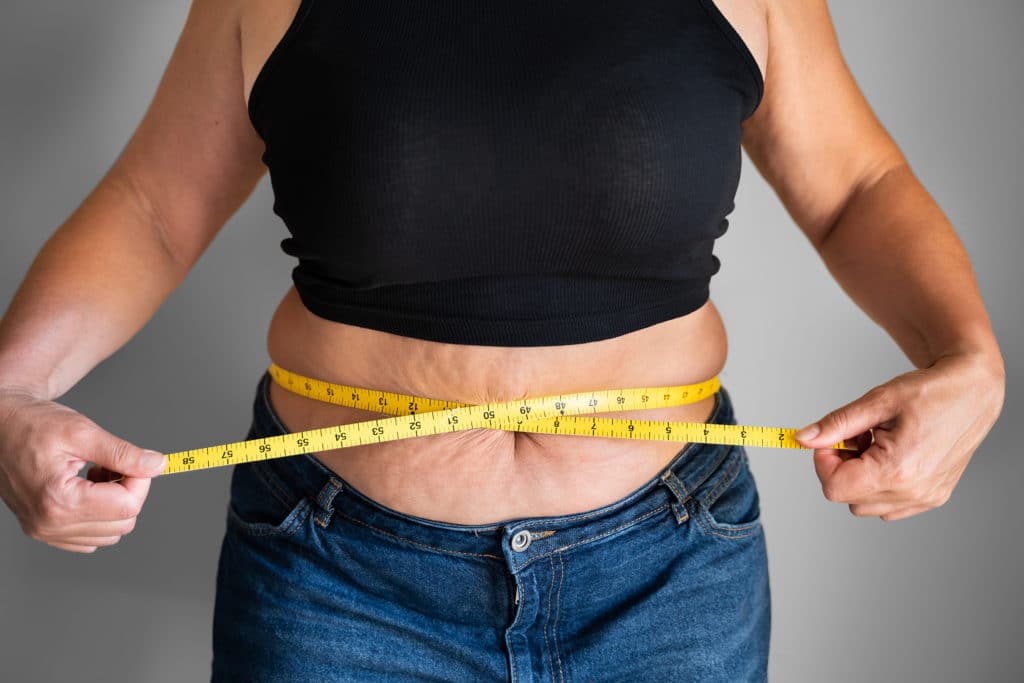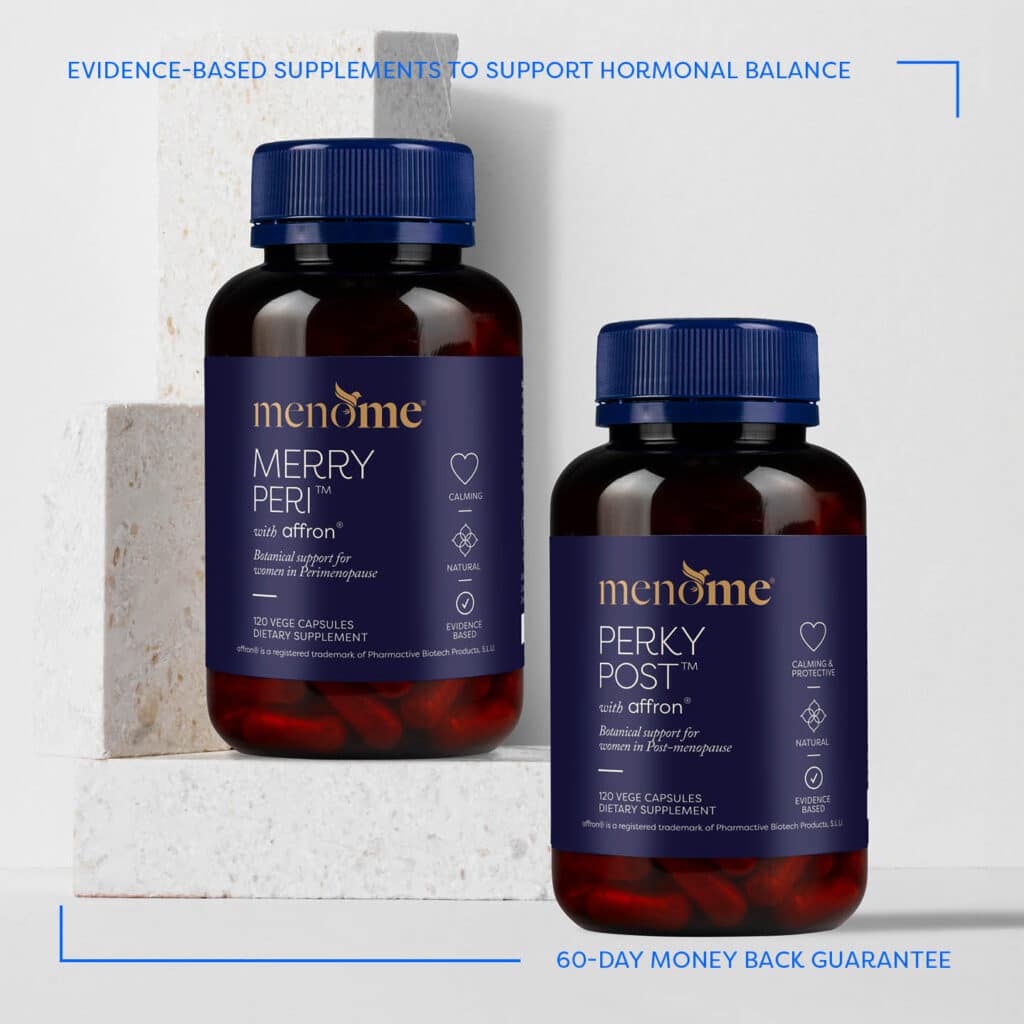Struggling With Menopause Belly Fat? Here’s Help
You’ve noticed the weight creeping around your middle – and no matter what you do, it won’t budge. Even your tried and true methods that always worked before suddenly seem…useless.
Frustrating? Absolutely. Disempowering? You bet.
But here’s the good news: menopause belly fat, sometimes known as meno belly, is real – and you can beat it.
At MenoMe® we understand how distressing midlife weight gain can be – especially when it settles stubbornly around your waist. But before you throw in the towel, know there’s a lot you can do to take back control.
One of the most common questions we get is:
‘‘Does menopause weight gain go away?’’
Short answer: yes, it definitely can.
Contrary to what you may have heard, menopause is not a guarantee of weight gain.. In fact, carrying excess belly fat can be a health risk – and one worth tackling head-on.
So why does it happen?
Hormonal changes during perimenopause and menopause often trigger imbalances that make foat storage (especially around the middle) more likely. These may include:
- Insulin resistance
- Leptin resistance
- Estrogen dominance
- High cortisol levels
- Underactive thyroid
On top of that, we naturally lose lean muscle as we age, which slows metabolism and reduces the number of calories we need to maintain our weight.
But here’s the thing: when you understand what’s going on in your body, you can respond with strategies that work – and we’ve got 8 of the best coming up.
Your Body Shape Will Change In Menopause
There – we’ve said it. Once your body shape begins transitioning through perimenopause and into post-menopause, your shape will change. And while that might feel confronting, it’s completely normal – and there’s a science behind it.
Menopause may change your shape, but it doesn’t define your health destiny.
Estrogen and Fat Distribution
One of the primary culprits? A natural decline in estrogen.
When you’re younger, estrogen encoourages fat storage around your hips and thighs. But as levels drop during menopause, fat begins to accumulate around the abdomen. This shift is part of your evolutionary biology and explains why many women move from an hourglass or pear shape to more of an apple shape.
“As estrogen declines, fat distribution shifts from peripheral to central – landing around the midsection.” – Journal of Endocrinology & Metabolism (Lovejoy et al., 2008)¹
Just like the changes experienced during puberty and pregnancy, menopause is a hormonally driven transition. So if you feel your post-menopausal body looks and feels different, you’re absolutely right – it probably does. And that’s okay.
What The Research Says
A few more kilos and a bit more belly fat are the completely normal during this stage. In fact, most women will gain between 1 and 2.5kg during the menopausal transition.
“On average, women gain 1-2.5kg during menopause, with a shift in body fat dsitribution.” – Mayo Clinic Proceedings (Manson et al., 2025)²
But When Does It Become A Concern?
While some fat gain is expected excess abdominal fat isn’t just cosmetic – it can increase the risk of chronic diseases such as:
- Obesity
- Type 2 diabetes
- Cardiovascular disease
- Post-menopausal breast cancer

Why “Eat Less, Exercise More” Doesn’t Work For Menopause
Let’s get one thing clear – menopause weight gain doesn’t usually go away on its own. But there’s plenty you can do to help it – once your understand what’s really going on.
But starving yourself or pushing harder in the gym won’t fix menopause belly fat – it may make it worse.
It’s Not About Willpower Or Calories
Despite what we’ve been taught, it’s not as simple as ‘calories in versus calories out’. In fact, slashing calories or going all-in on punishing workouts can backfrie – especially in midlife.
Your body is already under pressure from hormonal changes, and restrictive diets or high-intensity training can spike cortisol, your primary stress hormone. This stress response not only makes it harder to lose weight, but it may actually encourage fat storage around your belly.
“Excessive caloric restriction and high-intensity exercise may exacerbate cortisol levels, reducing fat loss efficacy.”
— Obesity Reviews (Tomiyama et al., 2011)¹
Meet Your Hormonal Trio: Cortisol, Insulin & Leptin
When cortisol is chronically elevated – whether from lifestyle stress or overtraining – it works to preserve energy (aka fat), especially in the abdominal area.
At the same time menopause often leads to:
- Insulin resistance – making it harder for your body to manage blood sugar, leading to fat storage.
- Leptin resistance – disrupting your brain’s ability to know when you’re full, leading to overeating and cravings.
And cortisol doesn’t care about your flat belly dreams – it cares about survival.
And guess where your body stores energy when it thinks your under threat? Right around your middle.
So What Does Work?
The key to beating menopause belly fat isn’t deprivation or burnout. It lies in:
Nourishing your body with balanced, anti-inflammatory meals
Moving in a way that supports your hormones – think strength training, walking, Pilates, yoga
Reducing stress with sleep, breathwork, rest days and joy-sparking activities.
Because when your body feels safe, supported and satisfied – it lets go of what it no longer needs.
What's Really In Your Belly Fat?
Not all fat is created equal – and when it comes to the midlife middle, understanding the type of fat matters. That’s because the composition of belly fat can affect your metabolism, hornones, and long-term health.
There are two main types of abdominal fat:
1. Subcutaneous Fat:
This is the soft, squishy fat you can see and pinch. It sits just under the skin and – while not ideal in excess – is generally less dangerous than the deeper kind.
2. Visceral Fat
This is the more harmful variety. It wraps around your internal organs, and is linked to:
- Insulin resistance
- High cortisol
- Elevated blood sugar
- Chronic inflammation
Oh, and by the way, visceral fat is metabolically active – and not in a good way.
Too much visceral fat can raise your risk of:
- Cardiovascular disease
- Type 2 diabetes
- Breast and bowel cancer
- Stroke
- Dementia
“Excess visceral fat is a significant predictor of metabolic disease in post-menopausal women.”
— The Lancet Diabetes & Endocrinology (Després, 2012)¹
Fat Loves Estrogen
And here’s another curveball: fat loves estrogen.
When your body has excess estrogen – from hormonal imbalance, stress, or environmental sources – it can get stored in fat tissue. And the kicker? Fat cells can actually produce and store estrogen, which continues the cycle.
And estrogen dominance and excess fat can create a feedback loop that makes weight loss harder.
That’s why supporting your hormones is just as important as diet and exercise when it comes to reducing belly fat.

8 Ways To Reduce Menopause Belly Fat
Before we dive in, don’t get too caught up in all the fad diets out there. While there’s no one-size-fits-all approach, research consistently shows that whole foods, lean proteins, healthy fats, and fewer processed foods are a strong foundation.
And the standout? The Mediterranean Diet is consistently associated with reduced menopause symptoms, sustainable weight management, and long-term health benefits.
“Science supports the Mediterranean Diet as a safe and effective way to manage menopause symptoms and belly fat.”
Let’s look at 7 evidence-informed ways to support your body and beat meno belly—naturally.
1. Love Your Gut
You’re hearing more about gut health for good reason – we finally understand just how important it is.
Your digestive system is home to trillions of microbes, known as your microbiome. These helpful bugs play a big role in digestion, hormone regulation, mood, immunity—and yes, weight management.
“A balanced gut microbiome can support metabolism and reduce belly fat.”
The good guys in your gut thrive on:
Fibre from veggies, whole grains, lentils and legumes
Fermented foods like sauerkraut, kimchi, and kefir (if you tolerate histamines)
In fact, our Happy Go Tummy® is a combination pre/probiotic and the perfect partner for loving your gut.
2. Eat More Vegetables
Menopause is the time to eat for function, not fads.
Vegetables are packed with gut-loving fibre, antioxidants, and nutrients that support detox pathways and hormone balance.
Cruciferous veggies – like broccoli, kale, Brussels sprouts, and cabbage—contain a compound called DIM (diindolylmethane), which helps regulate estrogen levels and reduce inflammation.
3. Cut Down On Sugar
Refined sugar is one of the biggest contributors to insulin resistance, inflammation, and – you guessed it – belly fat.
It feeds the bad bacteria in your gut and disrupts your blood sugar balance, which can cause cravings, mood swings, and fat storage around your middle.
Want to learn more? Check out our Sweet Enough? sugar series here. 💙
4. Load Up On PPFF (whole foods, phytoestrogens, protein, fat & fibre)
Your hormones need nutrients to thrive. Choose real, whole foods as close to nature as possible.
Key players include:
Healthy fats: Avocados, wild salmon, hemp seeds, walnuts, flaxseeds, olive oil
Lean protein: Beans, lentils, eggs, cottage cheese, chicken
Fibre & prebiotics: Oats, flaxseed, garlic, onions, legumes
Phytoestrogens: Foods like flax and sesame seeds, soy (tofu, edamame), and cruciferous veg help mimic and balance estrogen levels
Download our free Phytoestrogen Guide here.
5. Carbs Aren't The Enemy (but choose wisely)
Carbohydrates are one of the three essential macronutrients – and we need them. The key is to choose complex carbs, not refined ones.
Avoid:
White bread, pasta, biscuits, chips
Sugar-laden snack foods
Choose:
Whole grains, legumes, quinoa, sweet potato, oats
Tip: Aim for a plate that’s half veggies, a quarter protein, and small portions of healthy fats and complex carbs.
6. Manage Stress Like Its Your Job
Stress is unavoidable – but how you manage it matters, especially during menopause. Cortisol, your stress hormone, is directly linked to fat storage – particularly around the belly.
High cortisol worsens sleep, mood swings, cravings and midsection weight gain.
Try:
Daily walks in nature
Meditation or breathwork
Yoga or tai chi
Digital detox days
7. Prioritise Hormone Support
Most midlife weight struggles stem from hormonal chaos. Supporting your hormones naturally is essential.
MenoMe®’s Merry Peri® and Perky Post® are designed to support you during peri- and post-menopause, naturally and safely.
Also:
Avoid endocrine disruptors (e.g. plastics, pesticides, synthetic fragrances)
Choose clean skincare, household products, and organic food where possible
8. Move Your Body (smartly)
Weight loss is 80–90% what you eat, but movement matters. Especially resistance training, which:
Preserves muscle mass
Increases metabolism
Supports bone density
Enhances mood and sleep
Try:
Yoga or Pilates for stress and flexibility
Bodyweight or weight training
HIIT (High-Intensity Interval Training), which supports fat loss without prolonged cortisol spikes
The Bottom Line
Midlife weight gain and belly fat are complex. There are many moving parts, some of which we’ve covered here.
So, menopausal weight gain – especially around the middle – isn’t just about food or fitness. It’s a whole-body, whole-hormone experience.
Start small: pick one or two strategies and give them time. The goal isn’t perfection – it’s progress, nourishment, and feeling good in your skin again.
You’ve got this – and we’re here to help.
Have you got any questions or need more help? Don’t hesitate to contact me here.
References:
Lovejoy, J. C., et al. (2008). “Abdominal fat distribution and metabolic risk factors.” J Clin Endocrinol Metab.
Manson, J. E., et al. (2015). “Menopause management—getting clinical care back on track.” Mayo Clin Proc.
Toth, M. J., et al. (2000). “Menopause-related changes in body fat distribution.” Menopause.
Tomiyama, A. J., et al. (2011). “Chronic stress and cortisol: Implications for obesity and weight loss.” Obes Rev.
¹ Després, J. P. (2012). “Body fat distribution and risk of cardiovascular disease: an update.” The Lancet Diabetes & Endocrinology.










